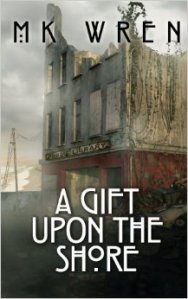These are my first impressions after reading A Gift Upon the Shore (M. K. Wren; 1990) in December 2009. I will be discussing A Gift Upon the Shore in future essays. Spoilers.
 A Gift Upon the Shore is a post-apocalyptic novel, set in the years following the utter destruction of human civilization. in a farmhouse on the Oregon coast, a small community has survived. But the age-old power struggle between knowledge and religion is still going on.
A Gift Upon the Shore is a post-apocalyptic novel, set in the years following the utter destruction of human civilization. in a farmhouse on the Oregon coast, a small community has survived. But the age-old power struggle between knowledge and religion is still going on.
The novel opens with the narrator, Mary Hope, describing her life as an old woman 40 years after humanity has destroyed itself. She lives on a seaside farm with a small group of survivors: a couple of older women, like herself; the first post-apocalypse generation, who lead the community; and their children. This is a literalist Christian group, although Mary doesn’t participate in their services. She is the children’s teacher, an arrangement she made with the group’s patriarchal leader, Jeremiah, in exchange for allowing his flock to live on the farm.
Mary decides to take one of the young men, Stephen, as her apprentice. She tells him the story of the apocalypse and what happened in the years following, and is writing the story down for him to have. The novel thus alternates between Mary’s first-person account in the present and her third-person chronicle of the recent past.
The young Mary came to the farm just as the world was disintegrating into chaos. Her bus was attacked by a band of “Rovers,” and Mary was rescued by Rachel Morrow, an artist who lived alone on the farm with a menagerie of animals. The two women foresaw disaster coming when their neighbors were brutally murdered and so stocked up for survival. Then the end came: nuclear war plus a raging epidemic wiped out nearly everyone.
Rachel and Mary eked out a subsistence for years, never finding another survivor. They had a purpose, though: to preserve the thousands of books they have salvaged for any future generations. They planned to seal the books up until printing was re-invented and future people had the means to reproduce them.
Then a man wandered down their beach, very sick and near collapse. The two women nursed him back to health. He explained that he came from a small Christian community not far away, which anticipated Armageddon, as they called it, and thus was prepared to survive. Although it was clear that their beliefs about God and the place of women were very different, Mary decided to marry Luke, as she believed it was her responsibility to have children, if she could. She moved to the compound for several months, but left when their leader and doctor refused to give a gravely wounded Rachel any medical help because he believed her to be a witch. It is Rachel’s history and beliefs that Mary particularly wants to chronicle for Stephen to teach the future generations.
In the present, Mary has taken in the remnants of the religious group, after Luke and the others died of illness. But Miriam, Jeremiah’s sister and co-leader in all but title, is suspicious of Mary’s teachings and tries to discredit her any way she can. Mary soon begins to suspect that Miriam might be planning to murder her or destroy the books Rachel worked so hard to preserve.
Clearly, this is a novel about women: their strengths, their weaknesses, their relationships with one another. The male characters are much less defined, and serve either as foes or as uneducated vessels, who need the wisdom of the women. By contrast, Rachel, Mary, and Miriam are strong and resourceful enough to survive the worst hardships, yet remain focused on what they perceive their responsibilities to the all-but-decimated human race to be. Each woman in concerned with preservation — of culture, of education of the young, of souls — and will do whatever they feel they have to, even sacrifice themselves, to remain true to their purpose.
The story drives forward suspensefully, switching back and forth in time until the past catches up with the present. The main flaw is that it is presented too straightforwardly. The religious group, represented by the clearly power-mad Miriam and the ineffectual Jeremiah, seems to offer nothing of value, while Rachel and Mary are presented as singlehandedly responsible for preserving the culture of mankind. I would have preferred more nuance, more shades of gray, some alternative points of view. The author’s tendency to sledgehammer her point comes out in other ways, such as the overkill apocalypse, which really could legitimately be mistaken for Armageddon by heaping plague and earthquakes on top of nuclear annihilation.
Despite these flaws, A Gift Upon the Shore is both poetic and exciting, and it is a convincing portrayal of a post-apocalyptic future. It is a worthwhile addition to the sub-genre.